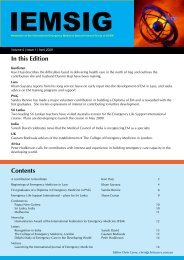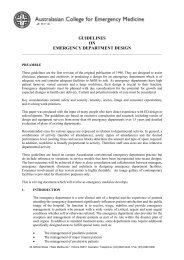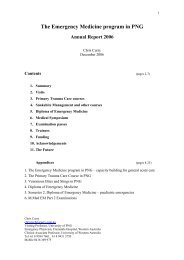You also want an ePaper? Increase the reach of your titles
YUMPU automatically turns print PDFs into web optimized ePapers that Google loves.
(ii) Loans and receivables<br />
Loans and receivables are non-derivative fi nancial assets with<br />
fi xed or determinable payments that are not quoted in an<br />
active market and are subsequently measured at amortised<br />
cost using the effective interest rate method.<br />
(iii) Held-to-maturity investments<br />
These investments have fi xed maturities, and it is the<br />
College’s intention to hold these investments to maturity.<br />
Any held-to-maturity investments held by the College are<br />
stated at amortised cost using the effective interest rate<br />
method.<br />
(iv) Available-for-sale fi nancial assets<br />
Available-for-sale fi nancial assets are non-derivative fi nancial<br />
assets not included in the above categories. Available-for-sale<br />
fi nancial assets are refl ected at fair value.<br />
(v) Financial liabilities<br />
Non-derivative fi nancial liabilities are subsequently measured<br />
at amortised cost.<br />
Fair Value<br />
Fair value is determined based on current bid prices for all<br />
quoted investments. Valuation techniques are applied<br />
to determine fair value for all unlisted securities.<br />
Impairment of Assets<br />
At the end of each reporting period, the College reviews the<br />
carrying values of its tangible and intangible assets to determine<br />
whether there is any indication that those assets have been<br />
impaired. If such an indication exists, the recoverable amount of<br />
the asset, being the higher of the asset’s fair value less costs to<br />
sell and value in use, is compared to the asset’s carrying value.<br />
Any excess of the asset’s carrying value over its recoverable<br />
amount is expensed to the statement of comprehensive income.<br />
Impairment testing is performed annually for goodwill and<br />
intangible assets with indefi nite lives.<br />
Where it is not possible to estimate the recoverable amount of<br />
an individual asset, the College estimates the recoverable amount<br />
of the cash-generating unit to which the asset belongs.<br />
Where an impairment loss on a revalued asset is identifi ed, this<br />
is debited against the revaluation surplus in respect of the same<br />
class of asset to the extent that the impairment loss does not<br />
exceed the amount in the revaluation surplus for that same class<br />
of asset.<br />
Intangibles<br />
Web-site costs are initially recognised on the cost basis. After<br />
initial recognition, web-site costs are carried at their cost, less<br />
any accumulated amortisation over their estimated useful life or<br />
fi ve years, and any accumulated impairment losses.<br />
Employee Benefi ts<br />
Provision is made for the College’s liability for employee benefi ts<br />
arising from services rendered by employees to the end of the<br />
reporting period. Employee benefi ts that are expected to be<br />
settled within one year have been measured at the amounts<br />
expected to be paid when the liability is settled, plus related<br />
on-costs. Employee benefi ts payable later than one year have<br />
been measured at the present value of the estimated future cash<br />
outfl ows to be made for those benefi ts.<br />
Contributions are made to employee superannuation funds<br />
and are charged as expenses when incurred. All employees are<br />
entitled to varying levels of benefi ts on retirement, disability<br />
or death. The superannuation plans or equivalent provide<br />
accumulated benefi ts. Contributions are made in accordance<br />
with the statutory requirements of each jurisdiction.<br />
Provisions<br />
Provisions are recognised when the College has a legal or<br />
constructive obligation, as a result of past events, for which it is<br />
probable that an outfl ow of economic benefi ts will result and<br />
that outfl ow can be reliably measured. Provisions recognised<br />
represent the best estimate of the amounts required to settle<br />
the obligation at reporting date.<br />
Cash and Cash Equivalents<br />
Cash and cash equivalents include cash on hand, deposits held atcall<br />
with banks, other short-term highly liquid investments with<br />
original maturities of six months or less, and bank overdrafts.<br />
Bank overdrafts are shown within short-term borrowings in<br />
current liabilities on the statement of fi nancial position.<br />
Revenue<br />
Revenue from the sale of goods is recognised when the goods<br />
are delivered to customers.<br />
Interest revenue is recognised on a proportional basis taking into<br />
account the interest rates applicable to the fi nancial assets.<br />
Subscriptions and Exam Fees<br />
Subscriptions and Exam Fees have been included on an accruals<br />
basis which is consistent with the accounting policy adopted in<br />
the previous year. The revenue is recognised when the service<br />
has been provided.<br />
Grant revenue from the DOHA Project “More Doctors for<br />
Emergency Departments <strong>2011</strong>-2013”, which commenced in June<br />
<strong>2011</strong>, is recognised in the statement of comprehensive income<br />
on a systematic basis over the periods in which the College<br />
recognises as expenses the related costs for which the grant is<br />
intended to compensate. All other grant revenue is recognised in<br />
the statement of fi nancial position as a liability until the service<br />
has been delivered to the contributor, at which time the net<br />
surplus/(defi cit) on the project is recognised in the statement of<br />
comprehensive income.<br />
Revenue from the providing of all other services is recognised<br />
when the service is provided.<br />
Borrowing Costs<br />
Borrowing costs directly attributable to the acquisition,<br />
construction or production of assets necessarily take a<br />
substantial period of time to prepare for their intended use or<br />
sale, are added to the cost of those assets, until such time as the<br />
assets are substantially ready for their intended use of sale.<br />
All other borrowing costs are recognised in income in the period<br />
in which they are incurred.<br />
Goods and Services Tax (GST)<br />
Revenues, expenses and assets are recognised net of the amount<br />
of GST, except where the amount of GST incurred is not<br />
recoverable from the Tax Offi ce. In these circumstances, the GST<br />
is recognised as part of the cost of acquisition of an asset or as<br />
part of an item of the expense. Receivables and payables in the<br />
balance sheet are shown inclusive of GST.<br />
Cash fl ows are presented in the statement of cash fl ows on<br />
a gross basis, except for the GST component of investing and<br />
fi nancing activities, which are disclosed as operating cash fl ows.<br />
<strong>ACEM</strong> <strong>Annual</strong> <strong>Report</strong> <strong>2011</strong><br />
49






